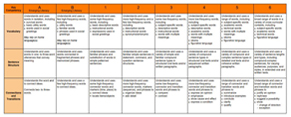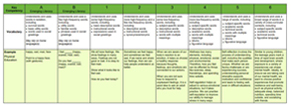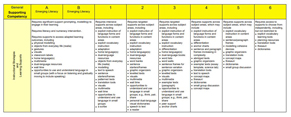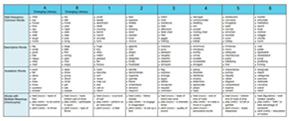Components of Benchmarks 2.0
Benchmark Indicators
 |
Benchmark indicators identify language knowledge and skills on a continuum from beginner to advanced. |
- The indicators can be used to inform programming, instruction, and selection of resources to support EAL students in learning the Alberta curriculum at their English proficiency level.
- Benchmark indicators represent the language a student will be able to use and understand by the end of each level.
- A student is considered to have achieved a particular proficiency level when they have consistently demonstrated most indicators in a variety of social and academic situations.
- Once a student has demonstrated most of the indicators in a level, they can be described as working at the next level.
See Reflecting on School Practices: Language Proficiency Assessment for more information on planning school-wide and classroom language proficiency assessment.
Proficiency Level Descriptions
Proficiency level descriptions support teachers, students, and parents in understanding a student’s English learning profile at each proficiency level, in each of the four language strands (listening, speaking, reading, and writing).
Students may work at different proficiency levels in their oral language (listening and speaking) and written language (reading and writing) or their receptive language (listening and reading) and productive language (speaking and writing). The time it will take to develop English fluency is different for each student.
Benchmark Examples
 |
Benchmark indicator examples illustrate benchmarks across subjects in listening, speaking, reading, and writing. |
- Teachers can reference the examples when they are considering what the student can understand in listening and reading and what they can produce in speaking and writing.
- Note that the benchmark indicators are the same for each strand.
- Examples are provided across subject areas to illustrate how teachers in any subject can plan instruction for and assess language development.
- Examples are written from a student’s perspective for the productive strands of speaking and writing.
- Examples are written from a teacher’s perspective or text source for the receptive strands of listening and reading.
Supporting Competencies
 |
Supporting competency indicators promote deeper understanding of learner profiles and provide effective strategies and supports for English as an additional language learning. |
- These can be used to identify more specific language learning needs and to identify possible strategies, supports, and next goals for language development.
- The supporting competency indicators are for supplementary, ongoing assessment.
- Depending on a student’s profile, including proficiency in other languages, background knowledge, previous educational experience, and life experience, the student may be at different proficiency levels for the various supporting competencies.
The supporting competencies are organized by the additional communicative focus within each strand, as shown in the chart below.
|
Listening |
Speaking |
Reading |
Writing |
|
Strand-specific Supporting Competencies |
Strategic Communication: Questioning
Auditory Discrimination
Oral Text Comprehension |
Strategic Communication: Participation and Interaction
Pronunciation
Grammar Observations |
Strategic: Decoding
Strategic: Fluency
Strategic: Comprehension |
Strategic: Writing Characteristics
Revising and Editing Supports
Grammar Observations |
English Language Continuums
 |
English language continuums for vocabulary, sentence structure, and connections and transitions provide teachers with examples of language in each key competency to |
- support in identifying language from simple to complex, high frequency to low frequency, social to academic, and concrete to abstract
- serve as a reference in guiding explicit language instruction within subject-area learning tasks
- identify what language the student has mastered
- decide the next goals for language learning
|





